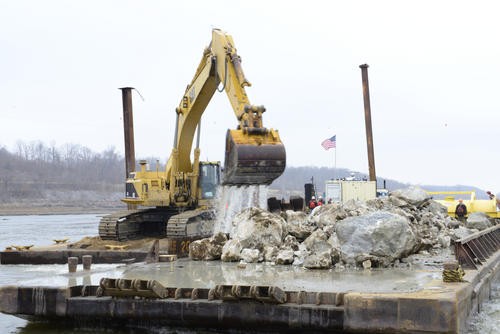
Mississippi River Rock Removal Makes Progress
THEBES, Il. – Workers contracted by the Army Corps of Engineers clear rocks from the river floor near Thebes, Il., Dec. 17, 2012. U.S. Coast Guard photo by Petty Officer 3rd Class Ryan Tippets.
By Tim Jones
The drought-depleted Mississippi River was closed to traffic today south of St. Louis as the U.S. Army Corps of Engineers reported progress removing submerged rock obstacles without resorting to blowing them up.
“We’re taking this least intrusive approach while we can,” said Sue Casseau, a public relations specialist for the U.S. Army Corps of Engineers’ St. Louis office.

The Corps had originally planned to plant explosives in the riverbed near the town of Thebes, near the southern tip of Illinois, beginning today. The river will be closed to barge traffic for 16 hours daily, reopening at 10 p.m. local time.
The Corps may still use explosives, though not today. Contractors are using backhoes to scape away or reduce the height of rock formations known as pinnacles, Casseau said. As water levels sink to near-record lows, the rocks loom as dangerous obstacles to vessels moving cargo on the nation’s busiest waterway.
Removal of the pinnacles is time-consuming and costly. The Army Corps said the $10 million project, covering a 15-mile stretch of the Mississippi, will last more than 30 days. Success will hinge largely on the weather.
“Rain, rain and more rain. There is no end game without more rain,” Major General John W. Peabody, the commander of the Corps’ Mississippi Valley region, told Bloomberg TV in an interview yesterday. “In about 30 days, we’ll have lowered the channel that has the rock obstructions in it by about a foot and a half. So that will take the navigation channel down about that amount.”
Unusual Levels
The last time the Corps had to resort to blasting was 1989.
“It’s unusual to have very low water like this,” Peabody said. “It doesn’t happen often, it happens periodically. Unfortunately when it does happen, it tends to go in multiyear stretches, so it’s possible that we may be seeing this for the next few years, as well depending again on what happens with the weather.”
Mississippi River barge traffic is slowing as the worst drought in five decades combines with a seasonal dry period to drop water levels to near-record lows, prompting shippers, including Archer-Daniels-Midland Co., to seek alternatives.
Industry groups have been pressing to get the work under way quicker to keep open a route through which $7 billion in goods pass in a typical December and January. Barge captains have long navigated the contours of the Mississippi River made famous by Mark Twain, carefully following a channel that winds between submerged pinnacles and other obstructions.
Lined-Up Barges
Ann McCulloch, a spokesperson for the American Waterways Operators, said there is a “concern that you could have barges lining up in a queue, waiting to go through.”
McCulloch said removal of the pinnacles addresses only part of the problem and that increasing the river flow has to be part of the solution. “There will be severe disruptions to the effect that the Mississippi River will be effectively closed by the end of the month,” McCulloch said in a telephone interview.
Last week, the agency began to increase the flow from Carlyle Lake on the Kaskaskia River system in southwest Illinois, which it said may add 6 inches of water to the lowest point in the Mississippi.
The river at St. Louis today was about 18 inches above the level at which barges may not be able to pass safely.
Copyright 2012 Bloomberg.

Subscribe for Daily Maritime Insights
Sign up for gCaptain’s newsletter and never miss an update
— trusted by our 109,123 members

Get The Industry’s Go-To News
Subscribe to gCaptain Daily and stay informed with the latest global maritime and offshore news

 Join The Club
Join The Club






